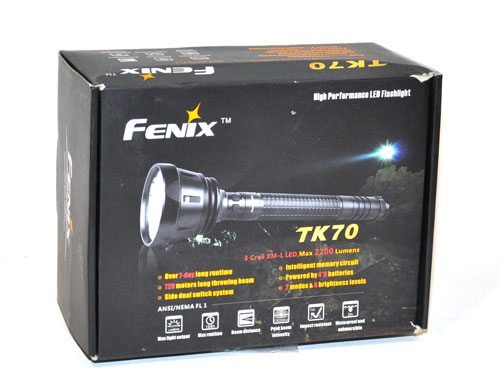
I have reviewed many fancy flashlights on The Gadgeteer, most of them relatively small, compact and for their size, pretty bright. Well, this time I am reviewing the Fenix TK70 courtesy of Fenix Outfitters. The TK70 is neither small nor lightweight but is supposed to be brighter than all my other flashlights combined….car light on high beam bright 🙂
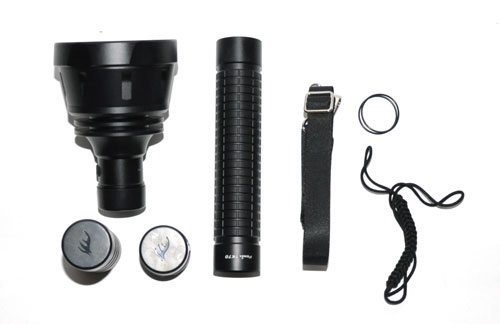
Along with the LED head, two body components and end cap, Fenix includes a lanyard, handle strap, and extra o-rings.
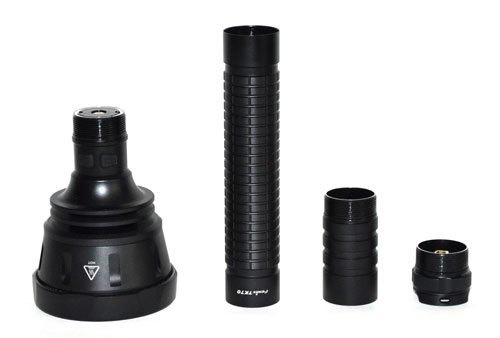
The pieces of the TK70 screw together very much like the lightsabers the Gadgeteer Kid and I built/reviewed a few years ago. The finely threaded aluminum tubes easily twist together. The aluminum is aircraft-grade and durable, coated with a Type III hard-anodized anti-abrasive finish.

The Fenix TK70 uses three high powered Cree XM-L LEDs with a (theoretical) lifespan of 50,000 hours. Its digitally regulated output maintains constant brightness. It also has reverse polarity protection, to protect from improper battery installation and over-discharge protection circuit to protect the rechargeable batteries effectively. To protect the LEDs, Fenix uses a ‘tough’ ultra-clear glass lens with anti-reflective coating.
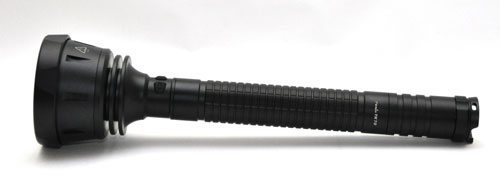
The TK70 measures 405mm (Length) x 40mm (Diameter) x 106mm (Head) and weighs 769-gram (excluding batteries). Its power source is four 1.5V D batteries. Along with being insanely bright, its dual switch system is simple and easy to operate as well. With the right batteries, the TK70 can run up to 7 days (lowest beam setting, I am sure) on a single charge.
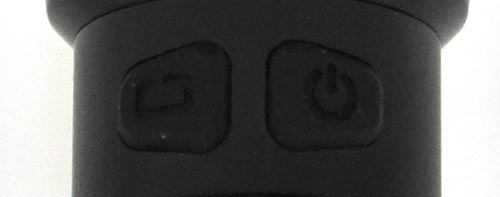
As I said, the dual switches are easy to use; the right button turns the flashlight on and off and the left button cycles through the four brightness/power levels.
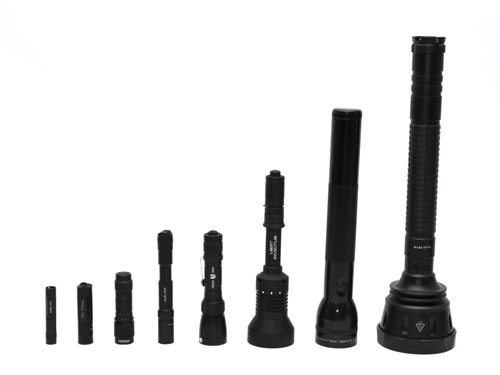
Without a doubt, the TK70 is huge. It is the biggest, longest, and heaviest flashlight I own and with its 2,200 lumens of brightness, it is by far the most powerful/brightest flashlight as well.
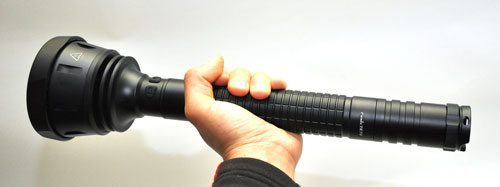
I have pretty large hands and as you can see, the TK70 is not petite. But considering its huge head, is surprisingly well balanced. The handle does look more like a lightsaber hilt than classic flashlight body. The body of the flashlight has good texture and grip-ability.
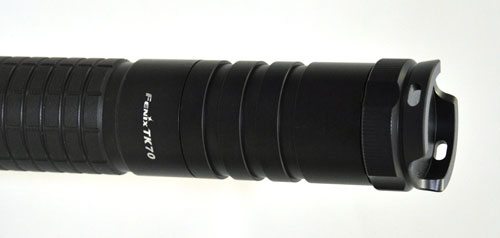
The butt of the flashlight has two connection points for the lanyard or handle strap.
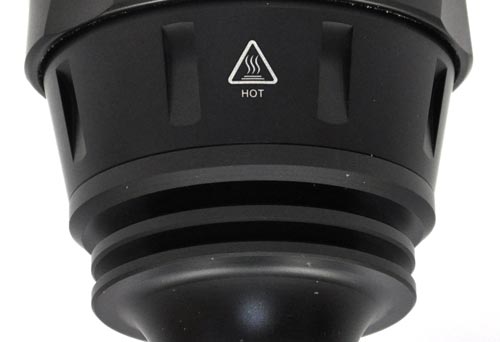
The LEDs are so powerful, there are ‘high-efficiency’ heat dissipation fins engineered into the TD70 that effectively radiate heat from the LEDs and electronics within the head. This helps protect the LEDs and electronics, ensuring that they do not overheat.
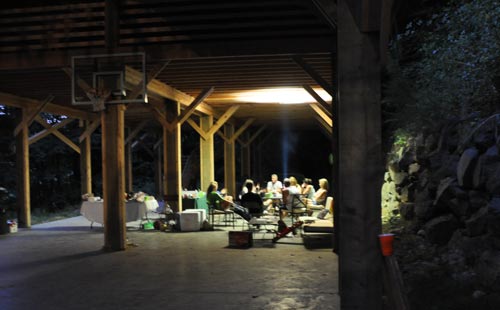
I was going to do a (relatively) detailed comparison of my various high powered flashlight (and still might), but I thought this photo says it all. We were celebrating the Gadgeteer Kid’s 10th birthday outdoors in our partially finished polebarn/garage. At this point, there are no lights and only temporary power to the building. Well, as the story goes, it was getting dark and to keep the get together going, unbeknownst to me, my wife had run into the house, grabbed the Fenix TK70 and had it alone, lighting the whole party. As you can see from the picture, it was Ark of the Covenant bright. Impressively, the TK70 literally illuminated the entire floor of the structure.
Uncommon praise: my wife rarely comments on the tech-items I review. On those few and far between moments when she chooses to comment, let’s just say, it’s often less than positive. Well, she surprised me one day while I was away on travel, when she texted me letting me know ‘that new flashlight is awesome.’ To give you a bit of perspective, I swear, my wife has only used the A-word a half dozen times in the 15 yrs I have known her…..
Due to its size, weight, and brightness, the Fenix TK70 is a somewhat niche flashlight/product. I envision this being used by search and rescue and/or cave explorers, folks who need to throw a huge amount of light. This flashlight is well made and relatively durable. Its aluminum construction, simple controls, and water resistant design makes it a great choice where durability counts. At $233, it is not inexpensive but if you calculate its lumens/dollar ratio, it is decent enough deal ;).
Gerber Gear 22-47162N Fast Draw Folding Assisted Opening Pocket Knife, Fine Edge, Black
$42.66 (as of 12/28/2025 17:02 GMT -06:00 - More infoProduct prices and availability are accurate as of the date/time indicated and are subject to change. Any price and availability information displayed on [relevant Amazon Site(s), as applicable] at the time of purchase will apply to the purchase of this product.)Gerber Gear EVO Jr. Folding Knife - Serrated Edge [22-41493]
$28.99 (as of 12/29/2025 13:22 GMT -06:00 - More infoProduct prices and availability are accurate as of the date/time indicated and are subject to change. Any price and availability information displayed on [relevant Amazon Site(s), as applicable] at the time of purchase will apply to the purchase of this product.)Product Information
| Price: | $232.95 |
| Manufacturer: | Fenix Light Limited |
| Retailer: | Fenix Outfitters |
| Requirements: |
|
| Pros: |
|
| Cons: |
|



Gadgeteer Comment Policy - Please read before commenting
About time you or someone else here reviewed this light. 😉
It’s very floody, but not the same as 65W HID. It does, however, have the advantage of instant-on and instant-off, takes 4 NiMH D-cells, and the 168 hours is on the lowest 20 lumen setting (aka: MagLite2D) with 9000 mAH or 10000 mAh D-cells. Those also keep it from being as heavy as the normal alkaline-based D-cells.
Incidentally, very nice action shot. Good way to show off what 2000 lumens looks like.
Thanks for the review. It would be nice to see reviews of lights like the sunwayman m30r – for larger lights, they have a form factor that I like more than super long lights and it would have been nice to see a good review on it before I bought mine.
I have the PD30 from Fenix because I didn’t want to fork the money for a Gladius. Hands down it’s the best bang for the buck and beats the heck out of a “police issue” Surefire 6P LED. Plus it’s compact and quite efficient on two CR123s.
I’d say Fenix is a good choice. If they keep improving their products like they have until now, they’ll become my flashlight brand of choice. Not sure if they have a weapon-mountable light yet, I’m curious about resilience of such a product made by Fenix.
http://www.fenixlight.com/viewnproduct.asp?id=47
They’ve sold pressure switches for years to mount their lights on guns. The TK-10, TK-11, TK-12, TA-20, TA-21, and TA-30 were all apparently mountable.
I always thought the issue with gunfire and LED lamps was the impact of springs on the batteries, more than anything else… or with incandescent lamps, the shock-absorption systems system prevented the bulb’s filaments from being shaken apart. That’s what Surefire made their reputation on initially. I suppose there could be problems with the LED’s too, depending on how the head’s potted.
I know about the pressure switches. It’s not the activation of the light that worries me but exactly what you touched – ability to withstand shock and recoil. It was more a question, along the lines of “anyone has seen a review of a weapon-mounted Fenix to day?”
http://www.fenixlight.com/viewnproduct.asp?id=79
The TK-20 and TK-21 were advertised as ‘hunting’ lights, and the TK-15’s features include ‘dual recoil-absorbing springs’. I can’t speak to the reliability of that last feature, but there’s posts about that light in some of the AR-15 forums.
http://www.candlepowerforums.com/vb/showthread.php?317515-Fenix-TK21-U2-%96-A-review-in-four-parts
Oh yes – and someone mounted a TK-21 on a shotgun, but noted the light was a bit too bright to use as a hunting rifle light.
Great review!!
I am thinking about buying a Olight voor a lot more money and this flashlight always has the possibility to use standard (and always ready / fully filled) batteries, where the Olight needs a special (and also a bit expensive battery holder.
I am interested now!!
Can you tell anything about the temperature of the head and the real life battery time of this flashligt at max??
I have the TK70 (and a TK40). With four powerex 11000 nimh batteries I notice it lasts only about a minute at 2200 before dropping down a level….
Just wondering if anyone had better battery recommendations….
Hi Jason,
I’ve seen the problems you mentioned of the TK70 from others, if this happens while still using the Nimh batteries, then the one you bought was a faulty product. just go to the store where you buy it for a exchange.
can anyone recommend a good set of ni-mh batteries and a good quality charger for the d cell batteries? I just purchased the fenix tk-70 and i learning alot about batteries and chargers all the sudden. Anyone have a suggestions?
I recently bought a tk70 and made the mistake of not buying high capacity batteries, i bought regular D cells and the light only stays at 2200 lumens for 20 seconds or less, does anyone know where i can buy high capacity d cells rechargeable or not?